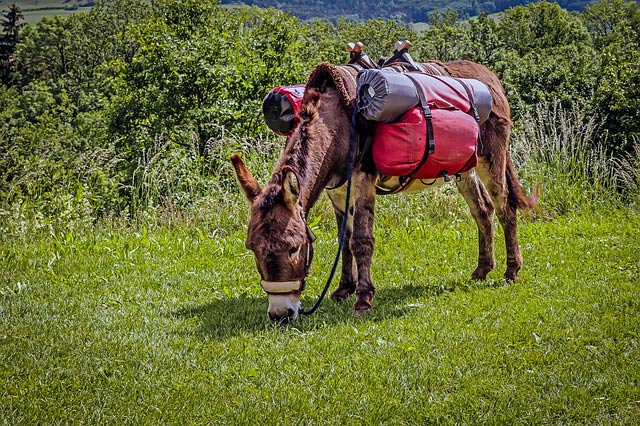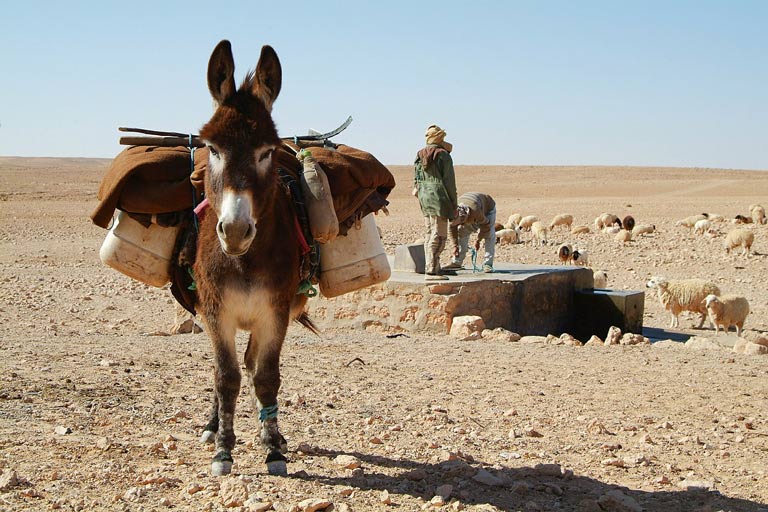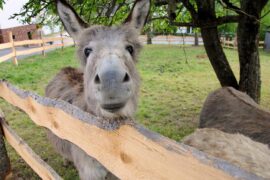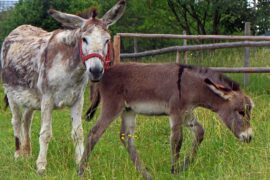Curious people often want to know how much a donkey can carry. The short answer is a lot. The long answer is that how much donkeys can carry while still avoiding overburdening depends. Donkeys are, and always have been, a crucial part of life and work for many people. According to data from 2020, there are approximately 44 million working donkeys around the world.
There are undoubtedly many uses for donkeys, including their ability to act as guardians of herds animals, companion animals, and even therapy animals. However, donkeys are most widely known for their ability to carry heavy loads. Before discussing how much donkeys can carry without being overburdened, let’s look at a bit of background.

Why donkeys?
For people all over the world, donkeys are an investment. In developing countries, donkeys can be the most valuable asset a person could own. They are essential for carrying food, water, and building materials, as well as for transportation. In other areas of the world, farmers use donkeys as livestock guardians and for carrying loads out to their fields. Donkeys are also often used for recreational purposes like hiking and camping in the backwoods. Adventurists load up their donkeys with all their gear and take off into the wilderness with their faithful companion.

Donkeys vs. horses
It is a common belief that donkeys are superior to most horses regarding their ability to carry heavy loads. Because of their anatomy, donkeys are much more suited to traverse challenging terrain. Donkeys’ limbs are closer to their body, and their backs are straighter than a horse’s back. Additionally, donkeys’ hooves are significantly straighter than horses’ hooves. Donkeys adapt better to arid climates than horses, so their hooves sustain a higher water content making them more elastic than horses’ hooves.
While commonly misjudged as stubborn or stupid, donkeys are exceedingly intelligent animals. When a donkey is acting stubborn, it would be wise to take a minute and consider what the animal might be trying to convey. They usually have a good reason for whatever it is they do. On the other hand, horses can be notorious for getting spooked when they encounter something unknown, dangerous, or frightening. Donkeys, instead, typically stop and evaluate the situation before determining their own best course of action.
The big reveal: How much can donkeys carry?
Most researchers agree that a healthy and physically fit donkey can carry 20% of its body weight. Although some believe donkeys can hold as much as 30% of their body weight. In truth, there are quite a few factors to consider when determining the load-bearing capabilities of any singular animal. Is the animal fully grown? Is the animal physically fit? How tough is the terrain to be traveled?
How to determine how much a donkey can carry
The simplest way to determine how much a donkey can carry would be to weigh the animal and then multiply the animals’ weight by 20%-25%. For example, if a donkey weighed 450 pounds, one would take 450 times 0.20 and 450 times 0.25 to calculate how much the animal could carry. In this equation, a 450-pound donkey could carry between 90 and 112.5 pounds of additional weight, including its saddle, halter, and rigging.
However, few people have access to the kind of scale that would be appropriate for donkeys. So, how does one figure out how much the donkey can carry? Instead of weighing on a scale, many people estimate a donkeys’ weight to determine its load-bearing capacity.
To estimate a donkeys’ weight, the measurement of its height gets multiplied by the girth circumference. The resulting number then gets multiplied by the length of the torso. That number is then divided by 300 to get the resulting estimated weight. This simple formula tells owners the estimated weight of a donkey. Then multiply the estimated weight by the percentage a donkey can carry. The result is the estimated weight a particular donkey can carry.

How to ensure the safety and well-being of a donkey
Even knowing that donkeys are intelligent animals, it is important to keep a close eye on them. Having been around since before written history, they have made it this far because of their survival instincts.
The best way to survive is to avoid showing any vulnerability – This behavior can make it difficult for their owners to tell when a donkey is sick or injured. If a donkey appears ill or in pain, it is likely that it has been suffering for a long time and is only showing signs as its symptoms worsen.
Attentive care is of the utmost importance. A cursory glance can tell most folks how well a donkey is handling a load. Beyond that, one can also look at physiological factors like the animals’ heart rate during and after carrying their pack. Stride parameters and gait kinematics can also help determine if an animal is carrying an appropriate weight. The animals’ respiratory rate during and after are also other areas examined. While some may think such monitoring to be excessive, overloading can lead to serious health problems like open sores, spinal injuries, alteration of behavior, and lameness.
Conclusion
Beyond just estimating what a reasonable load would be for a donkey, there are many other important factors to consider when deciding how much weight a donkey can carry. It is important to note that donkeys are living, breathing animals and not machines. Their ability to carry heavy loads will vary on conditions such as the weather, the terrain, their health and level of fitness, how well their load is balanced, and even their age. In conclusion, yes, donkeys can carry a lot. However, to keep this incredible animal working efficiently, its health must always remain a priority. If a donkey is well taken care of and never overburdened, it will continue to perform at the highest level for years on end.

![How Much Can Donkeys Carry? [Avoid Burdening] How-much-can-donkeys-carry](https://donkeyonfarm.com/wp-content/uploads/2022/04/How-much-can-donkeys-carry.jpg)

![Should Donkeys Be Stabled at Night? [With Alternatives to a Stable] Should-donkeys-be-stabled-at-night](https://donkeyonfarm.com/wp-content/uploads/2023/04/Should-donkeys-be-stabled-at-night-270x180.jpg)

![How Much Does it Cost to Maintain a Donkey? [Is it Expensive?] How-Much-Does-it-Cost-to-Maintain-a-Donkey](https://donkeyonfarm.com/wp-content/uploads/2022/09/How-Much-Does-it-Cost-to-Maintain-a-Donkey-270x180.jpg)

1 Comment
Pingback: Saddle Donkeys: Benefits, Training and More